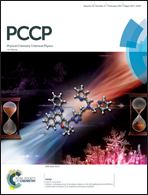Effect of electron spectral diffusion on static dynamic nuclear polarization at 7 Tesla†
Abstract
Here, we present an integrated experimental and theoretical study of 1H dynamic nuclear polarization (DNP) of a frozen aqueous glass containing free radicals at 7 T, under static conditions and at temperatures ranging between 4 and 20 K. The DNP studies were performed with a home-built 200 GHz quasi-optics microwave bridge, powered by a tunable solid-state diode source. DNP using monochromatic and continuous wave (cw) irradiation applied to the electron paramagnetic resonance (EPR) spectrum of the radicals induces the transfer of polarization from the electron spins to the surrounding nuclei of the solvent and solutes in the frozen aqueous glass. In our systematic experimental study, the DNP enhanced 1H signals are monitored as a function of microwave frequency, microwave power, radical concentration, and temperature, and are interpreted with the help of electron spin–lattice relaxation times, experimental MW irradiation parameters, and the electron spectral diffusion (eSD) model introduced previously. This comprehensive experimental DNP study with mono-nitroxide radical spin probes was accompanied with theoretical calculations. Our results consistently demonstrate that eSD effects can be significant at 7 T under static DNP conditions, and can be systematically modulated by experimental conditions.



 Please wait while we load your content...
Please wait while we load your content...